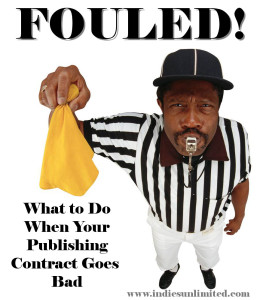 So, you’ve decided you want to self-publish your book because you’ve heard it’s a great way to get your masterpiece into the world. But now that you’ve started researching, you come across term after term that make no sense. While Google is great, it can also turn into a black hole that swallows up your valuable writing time. So here, we’re going to take a look at 10 terms every self-publisher should know. The goal is brevity and clarity, to get you a good grasp on what it means without sucking away your time. That said, let’s get to it.
So, you’ve decided you want to self-publish your book because you’ve heard it’s a great way to get your masterpiece into the world. But now that you’ve started researching, you come across term after term that make no sense. While Google is great, it can also turn into a black hole that swallows up your valuable writing time. So here, we’re going to take a look at 10 terms every self-publisher should know. The goal is brevity and clarity, to get you a good grasp on what it means without sucking away your time. That said, let’s get to it.
Traditional Publishing. Wait, but I want to self-publish, you say. Yes, but to understand the contrast, it’s good to take a quick view of the opposite method. Traditional publishing was the primary method used in the past. In this method, the publisher produces your book. They handle things like editing, covers, production (formatting ebook/paperback), distribution (getting it to online and/or brick-and-mortar stores), marketing, sales, and tracking. They may handle some liability issues, or they may not. Depends on your contract, and some publishers — for nonfiction — recommend you buy errors and omissions insurance. Traditional publishing often requires an agent (for major publishers), and deciding whether to move forward with your book is always the publisher’s decision. They reject way more books than they accept. Traditional publishers incur the expenses of publishing, including paying the author. Typically, authors get a small advance payment, and a small royalty as long as the book is published (once the advance is recouped). If the book is a bomb, the author is out no money. [Don’t forget, they make the majority of the money off your book, and they control everything from the title to the cover to the words inside. Check out our articles on Trad vs. Indie Publishing here.]
Self-Publishing. It means exactly what it sounds like — the process of publishing a book yourself. As a self-publisher, you are responsible for all the things a traditional publisher would provide: editing, cover, production, distribution, marketing, and tracking sales. Being responsible for it doesn’t mean you have to do it yourself. You can, and should, outsource some of these things (particularly editing and covers). You are also responsible for any legal issues that may arise. For example, in fiction, don’t use song lyrics without obtaining proper copyrights/permissions. An example in nonfiction: if you wrote a book called the Grape Diet that advocated eating a pound of green grapes in the morning and a pound of purple grapes in the evening and nothing else, and someone got terribly ill, you might have some liability (I’m not a lawyer, but nonfiction authors giving advice should consult one). While you incur all the expenses as a self-publisher, you keep all the profits or absorb all the losses.
Developmental Editing & Substantive Editing. These are two terms, but they are often lumped together. Developmental is a type of editing meant to help you develop the story. Typically, you share a detailed outline of the story with the editor, who makes sure you have the novel well-plotted and structured before you undertake the task of writing it. Someone who has already completed their manuscript may opt for substantive editing. This is where the editor looks at a completed manuscript and offers feedback on the overall structure, flow, plot, and major areas where there are problems with the story. Sometimes people use the term developmental and substantive editing interchangeably, because both types of editing are looking for structural flaws in the story. However, a developmental edit is typically done before the manuscript is completely written — to develop it, whereas a substantive edit is done after the manuscript is written, and may require significant rewrites and moving of chapters, deletion of plotlines, characters, etc.
 Copy Editing. This is the final phase of editing where a lot of changes might be made. The copy editor goes in and checks for grammar, spelling, and sentence flow. It’s more than a proofread, and will alert you to things like repeated words, clutch phrases, and thorny, hard-to-understand sentences. It is not as detailed as a substantive edit, so it’s not looking for plot and structural things, but will red flag and suggest reworks for individual sentences that are problematic.
Copy Editing. This is the final phase of editing where a lot of changes might be made. The copy editor goes in and checks for grammar, spelling, and sentence flow. It’s more than a proofread, and will alert you to things like repeated words, clutch phrases, and thorny, hard-to-understand sentences. It is not as detailed as a substantive edit, so it’s not looking for plot and structural things, but will red flag and suggest reworks for individual sentences that are problematic.
Proofreading. Proofreading is the final thing you should have done to a book. This should not be as expensive as a copy edit, as it’s a final check for grammar/spelling errors. It’s just to make sure nothing slipped through the cracks in the copy edit.
Pre-made covers. Hiring a cover designer to make a cover specifically for your book can be expensive. Some self-publishers choose to buy a pre-made cover, which is exactly what it sounds like. It’s a cover that a designer has made to represent a specific genre. If you like it, you ask the cover artist to put your title and author name on it. The good thing is these covers look professional. The bad news is, they’re often not as great as having one designed specifically for your book.
Copyright Registration. [This applies to U.S. only; People outside the U.S. should consult their own laws.] You may have heard that a copyright is vested as soon as you put pen to paper. And while that’s a nice concept, the only way to legally enforce that copyright is to register your work with the U.S. Copyright Office. The prerequisite to suing on a copyright violation is to own the copyright. Copyrights are not expensive. At present, they cost $35 to register a single work by a single author or $55 to register a multi-author work or a collection.
Pay-Per-Click Advertising. This is a way to advertise products, such as books online. Google has PPC advertising on its search engine. So, when you google a topic, you will get actual search results as well as results labeled “ad.” Your ad may be shown to millions of people, but in PPC advertising, you only pay when it gets clicked. Amazon offers those who publish through its Kindle Direct Publishing service access to PPC ads on the Amazon site. PPC advertising is generally helpful, but can be an expensive learning process, if you are paying way more for clicks than you are earning in sales. There are lots of courses to help understand PPC advertising.
POD (Print-On-Demand). It used to be that, in order to print a book, you had to make hundreds of copies of it. Print-on-demand allows a person to order your book online and the printer to print one book to fulfill that single order. If you sell your books online through any distribution channels as a self-publisher, then your book will likely be printed this way. It means you don’t have to order hundreds of books and store them in your basement to sell them. If you want to order hundreds of books you can, though.
Distribution Channels. These are the ways you distribute your book. Generally, most people will sell ebooks on ebook platforms, like Amazon, Barnes & Noble, Kobo, Apple, and the Google Play Store. You can also use an aggregator, like Smashwords or Draft2Digital, to distribute your books. There are print distribution channels as well.
Predatory publishers. Bonus word! Predatory publishers are people/organizations who claim to be publishers but are really just trying to  bilk you out of your hard-earned money. They charge you gobs of money and provide shoddy cover and editing services, as well as charge you for things you could easily do for free. They also tend to have you sign contracts that require thousands of dollars if you wish to terminate early. There’s way too much to go into here but, lucky for you, we have an entire section on predatory publishers!
bilk you out of your hard-earned money. They charge you gobs of money and provide shoddy cover and editing services, as well as charge you for things you could easily do for free. They also tend to have you sign contracts that require thousands of dollars if you wish to terminate early. There’s way too much to go into here but, lucky for you, we have an entire section on predatory publishers!
[Don’t forget, we have a glossary here at IU to help navigate the indie publishing world. Let us know if there are any words or phrases you’d like to see added.]

An invaluable post full of important information. Thank you.
Great info. Thanks!
Thank you so much for the invaluable tips.